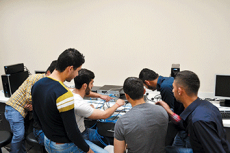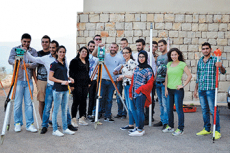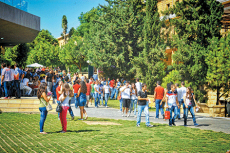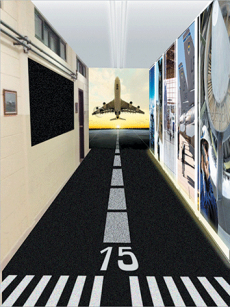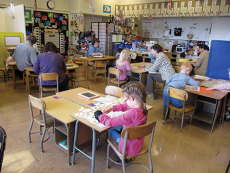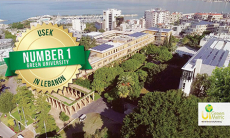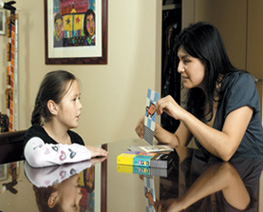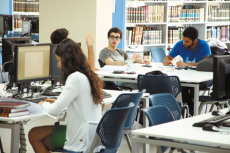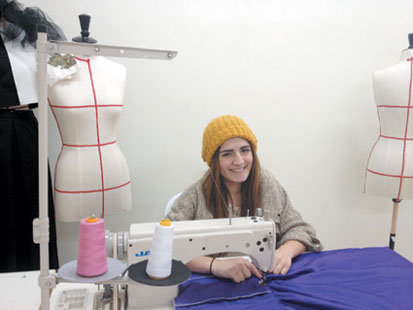Past, Present and Future Classroom
By Charbel Semaan, EdD.
Few decades ago, there was no sign of technology, no television, no telephones, no cars and no computers. Getting to the 21st century (the information age), we find that individuals’ lives have been invaded by new inventions taking humanity to a different level of living, working, teaching and studying (Chen, Looi and Chen, 2009). (Straf, 2003) said people live today in an era of technological change, which brings humanity both benefits and risks. Transportation technology brought people closer and enabled the global economy, information and communications technologies increased productivity and expanded outreach, and bio-technology can feed the world but with some risks to the environment and sources of food. Now, the world is looking for further enhanced technology from nanotechnology, artificial intelligence, robotics...What is next?
In education, we find that in the past years, the classroom consisted of four walls, a desk for the teacher, chairs and tables for the students and a traditional chalk board to write on, and schools were designed as a one-room school house. Comparing to todays’ classrooms, (Valenti, 2003) reported the lecture today is mostly technology-enhanced including a computer, a network connection, audiovisual presentation, as many teachers are still fighting hard to adapt the materials we find that many students have moved beyond the entire lecture concept. What will be the classroom in the future, after 20 years from now?
Before getting to what the classroom of the future should be, there must be several steps that a school must look at, such as the design of the school and the classes, the future projection of the technology that can be or will used in the classroom, and the educators of the future.
Starting with the design of the school, (Fisch, 2007) reported every member that works in schools and the architects that design them should try to predict the future by co-designing the classrooms. Also, try to figure out the future needs and be adequately prepared to give the students the minimal requirements of the 21st century, and the architects should not think of the building as just walls and floors, ceiling and doors, rather than having the vision to design learning spaces for potential future needs. (Fisch, 2007) added a question on how to be able to create a building that will serve the needs of educators and students far into the future, having such a rapid change. (Butterfield, 1999) stated in the future schools more security will be needed and believed that 80 percent of the security issues can be handled by the design, and when designing a new classroom. Where, there should be floor pockets cable hookups, and every student should have their technology tool ready to use.
Moreover, (Nair, 2000) stated classrooms of the future need to be redesigned so they function well in an environment of self-directed learning and collaborative projects, to have flexibility in classroom shapes and sizes using temporary partitions and moveable walls. Additionally, food courts should replace cafeterias to have greater variety in their diet and be able to eat lunch at their free time or when they are hungry, schools should have local community institutions to create shared common areas and high-quality media centers. (Nair, 2000) added we should see worktables in the classrooms and computer-friendly furniture. (Valenti, 2003) stated there are three acoustical components to be considered while building a classroom in the future, isolation between adjacent spaces, noise performance of the heating, ventilating and air conditioning, and the acoustical quality, which refers to the reverberant nature of the room.

What about educators, parents and students? (Fisch, 2007) stated educators are preparing students to be prepared in the workforce several years from the time they are in, without knowing what the world and the jobs needed by the time they got graduated. He added that the predicted top ten in demand jobs in 2010 did not exist in 2004, and in 2023, the computer will exceed the computation capabilities of the human being, and he asked what the educators would do to be prepared to such rapid change. For that, educators must be part of the future vision of education, change, trends and technology, and try to be part of it so they can move along with any change that occurs. (Butterfield, 1999) believed there must be space ramifications where every grade should be in one big class with several teachers that works together. According to (Nair, 2000), parents and local community members should be involved in literacy programs and participate in their children’s education, and students should have the chance to get involved with hand work real projects using technology to help in the future decision making, such as .
Looking at the classroom of the future technological vision, (Nair, 2000) reported most of the learning would come from informal learning such as socialization, interaction, distant learning, and real-time communication with a variety of educational partners. In addition, students in class will have access to laptop computers and internet when needed. Further, (Valenti, 2003) shared a future vision on how the classes should be without walls where the digital content becomes commonplace in the classroom, technology enables classroom. According to (Saleh, 2008), Technology is transforming nearly every aspect of society and culture, leading to a critical goal of meeting the challenge of technology literacy. The technology revolution is challenging and redirecting all forms of education, including higher education. The incorporation of technology into the teaching-learning process has become an important component throughout all areas of higher education.
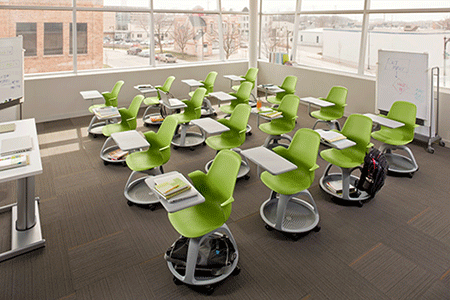
The 2020 classroom vision as seen by (Neumann and Kyriakakis, 2002) shared the idea of innovative information technology and pedagogy integration into the learning environment. Moreover, using the internet to create a virtual classroom, where students can login into a virtual class that transformed into a fully immersive aural and visual environment. That makes them feel like they are really in the same place together; they will be able to interact with each other and with the environment in a natural way with language and gestures. We see (Turoff and Hiltz, 1995) presented a future vision of having a virtual classroom, which allows the teacher to get complete control over the tools, and learning materials to weave in the learners as co contributors to growing web course knowledge, where they can have gaming, simulations, animation and multimedia. In addition, the educator plays the role of a facilitator of a collaborative learning process.
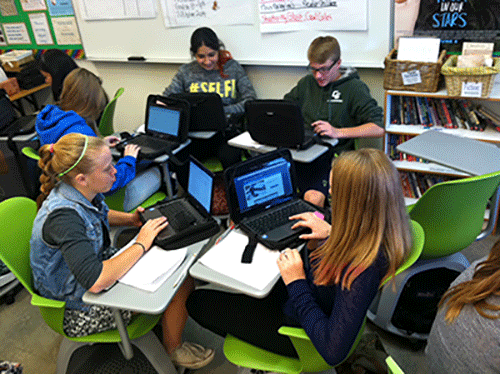
Furthermore, (Ongoz and Baki, 2010) surveyed lecturers from different countries about the state of education and instructional technologies by the year 2023. Additionally, the study showed that educators believe artificial intelligence will dominate by then, the size of hardware will be much smaller, mobile technology will used a lot in education, computers will be chip sized, placed into watches or jewelry. Further, (Ongoz and Baki, 2010) study resulted the communication system will be faster and related devices and tools will increase. Virtual reality/3D/Hologram will be integrated in education, new jobs will emerge by the year 2023 in the field of educational technology, out of class learning will increase and advanced technology will be used and the role of the teacher will be a facilitator and a good user of technology, and most of education will be distance education.
Furthermore, (Liou, Yang, Chen and Tarng, 2017) provided the advantages of VR (Virtual Reality) and AR (Augmented Reality): Where VR benefits the real time visualization that enhances students understanding of scientific concepts, as allows students to test scenarios and interact with nature of matter. On the other hand, the AR is a vivid learning environment where it can promote reality experience. Moreover, (Brown and Green, 2016) reported the VR tool is a low cost and effective item that can be used in the classroom filled with helpful resources for the students.
In conclusion, I believe that a classroom should have the appropriate size, flexibility, day light, acoustical components, and height of ceiling, colors, and floor tiles. Further, the classroom should include the appropriate pedagogical and technological materials that are available these days such as; a computer station (computer, speakers, microphone, printer, and so on), projector, interactive board, white board, laptops for the students, internet access, Use of VR, group and private areas, interactive activities, and so on. Further, the role of the teacher should be as a facilitator.
Further, no one can predict where technology will take us in the future, and we cannot forecast future inventions. For that, we cannot know what will be the technology that one may use after 20 years in the classrooms; as we cannot know what will be the role of the teacher by then, and the architects cannot envision the design of the future school. Nevertheless, all of the personnel related to the school should follow up with the current pedagogy and technological materials used, and be prepared for any added new tools to enhance the education system. Knowing everything is advancing so fast, the architects should be able to design classrooms with flexibility for any changes if needed in the future, the teachers should be following up and be ready to use any new educational or technological tool, also students, parents staff members and every member in the community should be prepared for any future change. Yet the question remains, to what extent our schools fit in today classrooms requirements? As, are they ready for the classrooms of tomorrow?
References
Brown, A. & Green, T. TechTrends (2016) 60: 517. https://doi.org/10.1007/s11528-016-0102-z
Chen, F. Looi, C. and Chen, W. (2009). Integrating technology in the classroom: a visual conceptualization of teachers’ knowledge, goals and beliefs. Journal of computer assisted learning. 25(5), 470-488.
Valenti, M. (2003). Creating the classroom of the future. The Sextant Group, Inc.
Nair, P. (2000). Schools for the 21st Century: Are You Ready? Design Share.
Butterfield, E. (1999). The Future of the Classroom. Design Share
Fisch, K. (2007). Creating a 2020 vision for School Design. Design Share
Lioum H.-H., Yang, S. J. H., Chen, S. Y., & Tarng, W. (2017). The influences of the 2D image-based augmented reality and virtual reality on student learning. Educational Technology & Society, 20 (3), 110-121.
Neumann, U., and Kyriakakis, C. (2002). 2020 Classroom. Retrieved from: infolab.usc.edu
Ongoz, S. and Baki, A. (2010). The opinions of lecturers about the state of education and instructional technologies by the year 2023. Procedia social and behavioral sciences, 9, 628-632
Straf, M. (2003), Statistics: The next generation. American Statistical Association, 98(461), 1-6.
Saleh, H. (2008). Computer self-efficacy of university faculty in Lebanon. Educational Technology Research and Development, 56(2), 229-240.
Turoff, M. and Hiltz, S. (1995). Software design and the future of the virtual classroom. Journal of Information Technology for Teacher Education, 4(2), 197-215.







